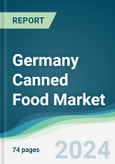The German canned food market is expected to experience a CAGR of 4.65% throughout the forecast period, reaching a market size of US$8,133.332 million by 2029. This represents a substantial increase from US$5,917.177 million recorded in 2022.
In Germany, there has been a notable surge in the demand for processed food items, primarily attributed to the increasing trend towards healthier diets and the accelerated pace of life among consumers. The German canned food market growth is influenced by various factors, with busy lifestyles and rising urbanization being prominent drivers. The preference for convenient food options has been on the rise, and canned food meets this demand by offering an extended shelf life, minimal preparation time, and easy storage, catering to the needs of individuals with hectic schedules. Affordability also plays a significant role in the popularity of canned food, as it tends to be more budget-friendly compared to fresh or frozen alternatives. This aspect becomes particularly relevant during periods of economic uncertainty or when food prices are on the rise. The convenience and cost-effectiveness of canned food have positioned it as a favored choice among consumers.In 2022, the largest European groundnut market served by commodity re-exporting companies was Germany, holding a substantial 39% share as per CBI, Ministry of Foreign Affairs. The increasing preference for ready-to-eat meals and convenience solutions, especially in the lunch and snack categories, has contributed to this market dominance. While Germany is a producer of various fruits and vegetables, including apples, strawberries, plums, carrots, onions, and asparagus, it relies on imports from developing countries during the off-season. Additionally, imports are necessary to meet the demand for tropical fruits that are not cultivated in Germany or Europe. This interplay of factors underscores the dynamic nature of the German canned food market, driven by both domestic production and global trade to fulfill diverse consumer preferences
Growing health awareness propels the Germany canned food market.
The rising awareness about health consciousness plays a pivotal role in propelling the canned food market in Germany. Canned food items, such as canned fish and canned fruits and vegetables, are integral components of a healthy diet. The canning process preserves essential nutrients, including protein, carbohydrates, fats, and fat-soluble vitamins, ensuring that they remain intact. This retention of nutritional value contributes significantly to providing the necessary dietary elements. The surge in the prevalence of major health conditions within Germany has heightened public awareness regarding health and wellness. In response to this trend, various fitness companies are capitalizing on the growing health awareness in the German market. For example, Basic-Fit announced plans in March 2022 to venture into the German fitness market, aiming to open 20 fitness clubs in the country. These fitness establishments are not only focused on physical fitness but also offer essential guidance on dietary consumption.While Germany stands as the largest European consumer of fresh fruit and vegetables, it also holds the position of being the largest importer of fresh produce. Developing countries play a crucial role as significant suppliers to meet the demands of the German market. In 2022, Germany imported 7.104647 billion euros worth of fruits and 5.58268 billion euros worth of vegetables. The high consumption of fruit and vegetables in Germany can be attributed to its large population and a GDP per capita of €46,182, reflecting high consumption expenditure. This highlights favourable prospects for the growth of canned fruits and vegetables in the country till the forecast period. Furthermore, Germany boasts the largest organic market in Europe, making it an attractive destination for suppliers from developing countries. This emphasis on organic products aligns with the health-conscious preferences of the German consumer base, contributing to the dynamic landscape of the food market in the country.
Segmentation:
By Type:
- Canned Fish/Seafood
- Canned Meat Products
- Canned Vegetables
- Canned Fruits
- Other Canned Foods
By Source:
- Organic
- Conventional
By Distribution Channel:
- Online
- Offline
- Supermarket/ Hypermarket
- Convenience Stores
- Others
Table of Contents
Companies Mentioned
- Del Monte (Germany) GmbH
- Hochland SE
- TULIP FOOD COMPANY A/S
- Feinkost Dittmann
- Bolton Group
Methodology

LOADING...
Table Information
| Report Attribute | Details |
|---|---|
| No. of Pages | 74 |
| Published | February 2024 |
| Forecast Period | 2022 - 2029 |
| Estimated Market Value ( USD | $ 5917.18 Million |
| Forecasted Market Value ( USD | $ 8133.33 Million |
| Compound Annual Growth Rate | 4.6% |
| Regions Covered | Germany |
| No. of Companies Mentioned | 5 |









